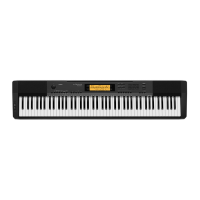Editing Auto Accompaniment Patterns
E-42
3.
Press a button from
bk
to
bn
to select the
Accompaniment Pattern you want to edit.
The name of the pattern will appear on the display.
Pattern selected by each button
4.
Press
bp
to select the instrument part you want
to edit.
The part number of the part you select will flash on the
display.
5.
Press
bs
.
This will display the rhythm number.
6.
Use the
cl
(10-key) [–] and [+] keys to select the
rhythm number you want to assign to the
instrument part you are editing.
A different rhythm number is assigned for each instrument
part.
• You can play the data of the currently selected rhythm
number by pressing
bo
.
• All of the eight instrument parts of an intro (I-1 to 8)
must have the same rhythm number. If you assign
rhythm 003 to I-1, for example, 003 also will be
assigned automatically to parts I-2 through I-8. If you
then assign rhythm 004 to part I-2, for example, I-1 and
all of the other parts also will change to 004. All of the
eight parts of an ending (E-1 to E-8) also must have the
same rhythm number.
7.
To edit the other contents, press
7
to display
the screen for the setting you want.
• Each press of
7
will cycle through the settings shown
below, from 1 through 6.
• Use the
cl
(10-key) [–] and [+] keys to change the
currently selected setting.
• You can play the current settings of the editable part by
pressing
bo
.
* Instrument parts 1 and 2 can be assigned drum set tones
(built-in tones 654 to 670) only.
8.
Repeat steps 4 through 7 as many times as
necessary to edit the parts you want for the
pattern you selected in step 3.
• If you change the rhythm number in step 6, the editable
contents (1 through 6 in the above table) you last
configured in step 7 of this procedure will be overwritten
with the settings of the newly selected rhythm.
9.
Repeat steps 3 through 8 as many times as
necessary to edit the accompaniment patterns
you want (intro through ending).
10.
Press
4
.
This will display a message asking if you want to save the
user rhythm.
bk
:Intro
bl
: Normal, Normal Fill-in
(Each press toggles the selection.)
bm
: Variation, Variation Fill-in
(Each press toggles the selection.)
bn
: Ending
Drm:Rh
y
.
bm
Variation selected
Part 6 (Chord 3)
Parts that contain data. Flashing: Part selected for editing.
Setting Type Display Settings
1 Part on/off Part On/Off
2 Tone number* Tone 001 - 653
3 Volume level Vol. 000 - 127
4
Left-right speaker balance
(panning)
Pan –63 - 0 - 64
5 Reverb depth (reverb send) Rvb 000 - 127
6 Chorus depth (chorus send) Cho. 000 - 127
CDP200R_e.book 42 ページ 2008年4月21日 月曜日 午後3時4分

